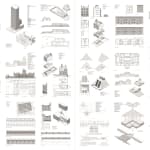John Burns
Form Follows Fuel, 2024
Digital print (diptych)
Unframed: 82 x 119 x 1 cm
Framed: 96 x 157 x 3 cm
Framed: 96 x 157 x 3 cm
Edition of 5
£ 400.00
Further images
This work is priced unframed. Please enquire for framing options. This drawing set was completed as part of research for the forthcoming book 'Form Follows Fuel', written by Barnabas Calder...
This work is priced unframed. Please enquire for framing options.
This drawing set was completed as part of research for the forthcoming book 'Form Follows Fuel', written by Barnabas Calder and Florian Urban with myself providing research support, carrying out calculations and illustrating. The research aimed to calculate the embodied energy within fifteen buildings throughout history, from the Great Pyramid to the Seagram Building, to provide a comparative analysis of energy used in construction in relation to fuel sources available. Digital models were created based on historical and measured information of these buildings from which material volumes were calculated to enable embodied energy to be derived. The drawing set was then extracted and presented from these models to illustrate the book in 'plates'. The artwork contains eighteen of these 'plates' complied together over two A1 sheets demonstrating the rigour, consistency and variety inherent in the research approach. The research aims to provide quantifiable embodied energy figures against historic buildings providing comparative analysis. The process of measuring, modelling and drawing of each building was crucial to this and shows the importance architectural drawing is in this new field of architectural history.
This drawing set was completed as part of research for the forthcoming book 'Form Follows Fuel', written by Barnabas Calder and Florian Urban with myself providing research support, carrying out calculations and illustrating. The research aimed to calculate the embodied energy within fifteen buildings throughout history, from the Great Pyramid to the Seagram Building, to provide a comparative analysis of energy used in construction in relation to fuel sources available. Digital models were created based on historical and measured information of these buildings from which material volumes were calculated to enable embodied energy to be derived. The drawing set was then extracted and presented from these models to illustrate the book in 'plates'. The artwork contains eighteen of these 'plates' complied together over two A1 sheets demonstrating the rigour, consistency and variety inherent in the research approach. The research aims to provide quantifiable embodied energy figures against historic buildings providing comparative analysis. The process of measuring, modelling and drawing of each building was crucial to this and shows the importance architectural drawing is in this new field of architectural history.
Join our mailing list
Join our email list to be the first to hear about RSA exhibitions, events and opportunities.
* denotes required fields
We will process the personal data you have supplied in accordance with our privacy policy (available on request). You can unsubscribe or change your preferences at any time by clicking the link in our emails.






